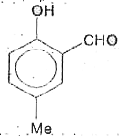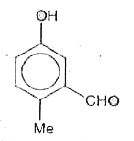Reimer-Tiemann reaction involves an aryl carbanion/enolate anion and also −CCl3 derived from the action of strong bases on CHCl3, though the latter has only a transient existence decomposing to CCl2, a highly electron deficient electrophile that attacks the aromatic nucleus, the product from phenoxide ion is after acidification, very largely the o-aldehyde plus just a small amount of p-isomer.
Name the electrophile attacking carbanion in the above reaction.
Chloroform
Trichloromethyl anion
dichlorocarbene
hydrogen ion
The correct Answer is:C
Related Playlists
- BOOK - FIITJEECHAPTER - ALDEHYDES AND KETONES EXERCISE - ASSIGNMENT PROBLEMS (OBJECTIVE) COMPREHENSION-II3videos
ALDEHYDES AND KETONES
- BOOK - FIITJEECHAPTER - ALDEHYDES AND KETONES EXERCISE - ASSIGNMENT PROBLEMS (OBJECTIVE) MATRIX-MATCH TYPE QUESTIONS6videos
ALDEHYDES AND KETONES
- BOOK - FIITJEECHAPTER - ALDEHYDES AND KETONES EXERCISE - ASSIGNMENT PROBLEMS (OBJECTIVE) LEVEL - II24videos
ALDEHYDES AND KETONES
- BOOK - FIITJEECHAPTER - ALCOHOLS, ETHERS AND PHENOLS EXERCISE - SINGLE INTEGER ANSWER TYPE QUESTIONS7videos
ALCOHOLS, ETHERS AND PHENOLS
- BOOK - FIITJEECHAPTER - ALKYL AND ARYL HALIDESEXERCISE - NUMERICAL BASED QUESTIONS1videos
ALKYL AND ARYL HALIDES
Similar Practice Problems
- Question 1 - Select One
Reimer-Tiemann reaction involves an aryl carbanion/enolate anion and also −CCl3 derived from the action of strong bases on CHCl3, though the latter has only a transient existence decomposing to CCl2, a highly electron deficient electrophile that attacks the aromatic nucleus, the product from phenoxide ion is after acidification, very largely the o-aldehyde plus just a small amount of p-isomer.
Reimer-Tiemann reaction involvesAnucleophilic substitutionBelectrophilic substitutionCfree radical mechanismDionic mechanism - Question 1 - Select One
Reimer-Tiemann reaction involves an aryl carbanion/enolate anion and also −CCl3 derived from the action of strong bases on CHCl3, though the latter has only a transient existence decomposing to CCl2, a highly electron deficient electrophile that attacks the aromatic nucleus, the product from phenoxide ion is after acidification, very largely the o-aldehyde plus just a small amount of p-isomer.
The product of the reaction in the reaction in the above paragraph is largelyAm-salicylaldehydeBp-salicylaldehydeCo-salicylaldehydeDnone of the above - Question 1 - Select One
Reimer-Tiemann reaction involves an aryl carbanion/enolate anion and also −CCl3 derived from the action of strong bases on CHCl3, though the latter has only a transient existence decomposing to CCl2, a highly electron deficient electrophile that attacks the aromatic nucleus, the product from phenoxide ion is after acidification, very largely the o-aldehyde plus just a small amount of p-isomer.
If the above reaction is carried out on the anion of p-hydroxytoluene, what will be theproduct/products?A B
B CBoth (A) and (B)DNone of the above
CBoth (A) and (B)DNone of the above - Question 1 - Select One
Reimer-Tiemann reaction involves an aryl carbanion/enolate anion and also −CCl3 derived from the action of strong bases on CHCl3, though the latter has only a transient existence decomposing to CCl2, a highly electron deficient electrophile that attacks the aromatic nucleus, the product from phenoxide ion is after acidification, very largely the o-aldehyde plus just a small amount of p-isomer.
CO2 can attack in a similar manner to : CCl2 on phenoxide ion. Following-a similar mechanism, major product will beAo-hydroxybenzoateBp-hydroxybenzoateCm-hydroxybenzoateDnone of the above - Question 1 - Select One
Borane is an electron deficient compound. It has only six valence eletons, so the boron atom lacks an octet. Acquiring an octet is the driving force for the unusual bonding structure found in boron compounds. As an electron deficient compound, BH3 is a strong electrophile, capable of adding to a double bond. This hydroboration of double bond is though to oC Cur in one step, with the boron atom adding to the less highly substituted end of the double bond. In transition state, the boron atom withdraws electrons from the pi bond and the carbon at theother end of the double bond acquires a partial positive charge. This positive charge is more stable on the more highly subsituted carbon atom. The second step is the oxidation of boron atom, removing it from carbon and replacing it with hydroxyl group by using H2O2/OH¯¯¯¯¯...
The simultaneous addition of boron and hydrogen to the double bond leads to a syn addition. Oxidation of the trialkyl borane replaces boron with a hydroxyl group in the same stereochemical position. Thus, hydroboration of alkenen is an example of steropecific reaction, in which different steroisomers of starting compounds react to give different steroisomers of the product.
CH3−CH3∣C∣CH3−CH=CH2 (i)BH3/THF−−−−−−−−−−→(ii)H2O2/OH¯¯¯¯¯..Z.
Z is :AOptically active 1∘−alcoholBOptically active 2∘−alcoholCOptically inactive 1∘−alchoholDOptically inactive 3∘−alcohol - Question 1 - Select One
Borane is an electron deficient compound. It has only six valence eletons, so the boron atom lacks an octet. Acquiring an octet is the driving force for the unusual bonding structure found in boron compounds. As an electron deficient compound, BH3 is a strong electrophile, capable of adding to a double bond. This hydroboration of double bond is though to oC Cur in one step, with the boron atom adding to the less highly substituted end of the double bond. In transition state, the boron atom withdraws electrons from the pi bond and the carbon at theother end of the double bond acquires a partial positive charge. This positive charge is more stable on the more highly subsituted carbon atom. The second step is the oxidation of boron atom, removing it from carbon and replacing it with hydroxyl group by using H2O2/OH¯¯¯¯¯...
The simultaneous addition of boron and hydrogen to the double bond leads to a syn addition. Oxidation of the trialkyl borane replaces boron with a hydroxyl group in the same stereochemical position. Thus, hydroboration of alkenen is an example of steropecific reaction, in which different steroisomers of starting compounds react to give different steroisomers of the product.
_E01_058_Q01.png) (i)BH3/THF−−−−−−−−−−→(ii)H2O2/OH¯¯¯¯¯..product. The product is AThreo cyclic alchoholBErythreo cyclic alcoholCOptically active alchoholDBoth (B) and (C)
(i)BH3/THF−−−−−−−−−−→(ii)H2O2/OH¯¯¯¯¯..product. The product is AThreo cyclic alchoholBErythreo cyclic alcoholCOptically active alchoholDBoth (B) and (C) - Question 1 - Select One
Borane is an electron deficient compound. It has only six valence eletons, so the boron atom lacks an octet. Acquiring an octet is the driving force for the unusual bonding structure found in boron compounds. As an electron deficient compound, BH3 is a strong electrophile, capable of adding to a double bond. This hydroboration of double bond is though to oC Cur in one step, with the boron atom adding to the less highly substituted end of the double bond. In transition state, the boron atom withdraws electrons from the pi bond and the carbon at theother end of the double bond acquires a partial positive charge. This positive charge is more stable on the more highly subsituted carbon atom. The second step is the oxidation of boron atom, removing it from carbon and replacing it with hydroxyl group by using H2O2/OH¯¯¯¯¯...
The simultaneous addition of boron and hydrogen to the double bond leads to a syn addition. Oxidation of the trialkyl borane replaces boron with a hydroxyl group in the same stereochemical position. Thus, hydroboration of alkenen is an example of steropecific reaction, in which different steroisomers of starting compounds react to give different steroisomers of the product.
Find the product of following reaction
_E01_055_Q01.png) A
A_E01_055_O01.png) B
B_E01_055_O02.png) C
C_E01_055_O03.png) D
D_E01_055_O04.png)
- Question 1 - Select One
Borane is an electron deficient compound. It has only six valence eletons, so the boron atom lacks an octet. Acquiring an octet is the driving force for the unusual bonding structure found in boron compounds. As an electron deficient compound, BH3 is a strong electrophile, capable of adding to a double bond. This hydroboration of double bond is though to oC Cur in one step, with the boron atom adding to the less highly substituted end of the double bond. In transition state, the boron atom withdraws electrons from the pi bond and the carbon at theother end of the double bond acquires a partial positive charge. This positive charge is more stable on the more highly subsituted carbon atom. The second step is the oxidation of boron atom, removing it from carbon and replacing it with hydroxyl group by using H2O2/OH¯¯¯¯¯...
The simultaneous addition of boron and hydrogen to the double bond leads to a syn addition. Oxidation of the trialkyl borane replaces boron with a hydroxyl group in the same stereochemical position. Thus, hydroboration of alkenen is an example of steropecific reaction, in which different steroisomers of starting compounds react to give different steroisomers of the product.
_E01_056_Q01.png)
Y is :A_E01_056_O01.png) B
B_E01_056_O02.png) CbothDNone of these
CbothDNone of these
Similar Questions
Borane is an electron deficient compound. It has only six valence eletons, so the boron atom lacks an octet. Acquiring an octet is the driving force for the unusual bonding structure found in boron compounds. As an electron deficient compound, BH3 is a strong electrophile, capable of adding to a double bond. This hydroboration of double bond is though to oC Cur in one step, with the boron atom adding to the less highly substituted end of the double bond. In transition state, the boron atom withdraws electrons from the pi bond and the carbon at theother end of the double bond acquires a partial positive charge. This positive charge is more stable on the more highly subsituted carbon atom. The second step is the oxidation of boron atom, removing it from carbon and replacing it with hydroxyl group by using H2O2/OH¯¯¯¯¯...
The simultaneous addition of boron and hydrogen to the double bond leads to a syn addition. Oxidation of the trialkyl borane replaces boron with a hydroxyl group in the same stereochemical position. Thus, hydroboration of alkenen is an example of steropecific reaction, in which different steroisomers of starting compounds react to give different steroisomers of the product.
CH3−CH3∣C∣CH3−CH=CH2 (i)BH3/THF−−−−−−−−−−→(ii)H2O2/OH¯¯¯¯¯..Z.
Z is :View SolutionBorane is an electron deficient compound. It has only six valence eletons, so the boron atom lacks an octet. Acquiring an octet is the driving force for the unusual bonding structure found in boron compounds. As an electron deficient compound, BH3 is a strong electrophile, capable of adding to a double bond. This hydroboration of double bond is though to oC Cur in one step, with the boron atom adding to the less highly substituted end of the double bond. In transition state, the boron atom withdraws electrons from the pi bond and the carbon at theother end of the double bond acquires a partial positive charge. This positive charge is more stable on the more highly subsituted carbon atom. The second step is the oxidation of boron atom, removing it from carbon and replacing it with hydroxyl group by using H2O2/OH¯¯¯¯¯...
The simultaneous addition of boron and hydrogen to the double bond leads to a syn addition. Oxidation of the trialkyl borane replaces boron with a hydroxyl group in the same stereochemical position. Thus, hydroboration of alkenen is an example of steropecific reaction, in which different steroisomers of starting compounds react to give different steroisomers of the product.
CH3−CH3∣C∣CH3−CH=CH2 (i)BH3/THF−−−−−−−−−−→(ii)H2O2/OH¯¯¯¯¯..Z.
Z is :View Solution

